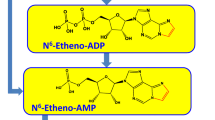Abstract
Preincubation with [14C] adenine labeled the nucleotide fraction of isolated cerebral tissues, which subsequently released 0.18% of their14C content per minute, a proportion increased threefold by electrical excitation. Of the14C released, 2–3% was as 5′-adenine nucleotides and about 2% as cyclic adenosine 3∶5-monophosphate (cAMP). Among the 5′-nucleotides AMP greatly preponderated, and ATP and ADP were detected. When added to (unlabeled) incubating neocortical tissue, ATP and AMP yielded adenosine as the major product, with smaller quantities of inosine and hypoxanthine, to effluent fluids. cAMP so added yielded 5′-nucleotides and the other compounds named; adenosine yielded mainly inosine and hypoxanthine. Results from these reactions and others in which theophylline was included led to the conclusion that an appreciable proportion of the effluent [14C] adenosine, inosine, and hypoxanthine derived from cAMP.
Similar content being viewed by others
References
McIlwain, H. 1976. Transport of adenine derivatives in tissue of the brain. Pages 253–264in Levi, G., Battistin, L., andLajtha, A. (eds.), Transport phenomena in the nervous system, Plenum Press, New York.
Pull, I., andMcIlwain, H. 1972. Metabolism of [14C] adenine and derivatives by cerebral tissues, superfused and electrically stimulated.Biochem. J. 126:965–973.
Pull, I., andMcIlwain, H. 1972. Adenine derivatives as neurohumoural agents in the brain. The quantities liberated on excitation of superfused cerebral tissues.Biochem. J. 130:975–981.
Pull, I., andMcIlwain, H. 1973. Output of [14C] adenine nucleotides and their derivatives from cerebral tissue. Tetrodotoxin-resistant and calcium ion-requiring components.Biochem. J. 136:893–901.
McIlwain, H. 1974. Adenosine 3′:5′-cyclic monophosphate and its precursors in the brain: a cyclase-containing adenine-uptake region.Trans. Biochem. Soc. 2:379–382.
Daly, J. 1975. Role of cyclic nucleotides in the nervous system. Pages 47–130 and 361–374in Iversen, L. L., Iversen, S. D., andSnyder, S. H. (eds.), Handbook of psychopharmacology, Vol. 5, Plenum Press, New York.
McIlwain, H. 1975. Pages 116–121 and 144–156in Practical neurochemistry, 2nd ed., Churchill Livingstone, London.
Randerath, K., andRanderath, E. 1967. Thin-layer separation methods for nucleic acid derivatives. Pages 323–350in Grossman, L., andMoldave, K. (eds.), Methods in enzymology, Vol. 12A, Academic Press, London.
McIlwain, H., andBachelard, H. S. 1971. Biochemistry and the central nervous system, 4th ed., Churchill Livingstone, London.
McIlwain, H. 1972. Regulatory significance of the release and action of adenine derivatives in cerebral systems.Biochem. Soc. Symp. 36:69–85.
McIlwain, H. 1976. Translocation of neural modulators. A second category of nerve signal.Neurochemical Research 1:351–368.
Kakiuchi, S., Rall, T. W., andMcIlwain, H. 1969. The effect of electrical stimulation upon the accumulation of adenosine 3′:5′ phosphate in isolated cerebral tissue.J. Neurochem. 16:485–491.
Barberis, C., McIlwain, H., andNewman, M. E. 1976. The persistence, translocation and metabolism of cyclic adenosine 3′:5′ monophosphate generated in isolated cerebral tissues by electrical excitation.Biochem. Soc. Trans. 4:748–749.
Douglas, W. W., andPoisner, A. M. 1966. Extrusion of ATP (unhydrolysed) during release of catecholamines.J. Physiol. London 183:249–256.
Ashworth, J. M. 1974. Adenosine 3′:5′ cyclic monophosphate and the cellular slime molds.Biochem. Soc. Trans. 2:382–385.
Gerisch, G., Hulser, D., Malchow, D., andWick, U. 1975. Cell communication by periodic cyclic-AMP pulses.Phil. Trans. Roy. Soc. London Ser. B 272:181–192.
Hardman, J. G. 1971. Other cyclic nucleotides. Pages 400–421in Robison, G. A., Butcher, R. W., andSutherland, E. W. (eds.), Cyclic AMP, Academic Press, New York.
Olsson, R. A., Gentry, M. K., andTownsend, R. S. 1973. Adenosine metabolism properties of dog heart microsomal 5′-nucleotidase.Adv. Exptl. Biol. Med. 39:27–39.
Lindle, T., Heinl-Sawaya, M. C. B., andCramer, H. 1975. Compartmentation of a substrate pool for adenylate cyclase in rat superior cervival ganglion.Biochem. Pharmacol. 24:947–950.
Cramer, H., Ng, L. K. Y., andChase, T. N. 1972. Effect of probenacid on levels of cyclic AMP in human cerebrospinal fluid.J. Neurochem. 19:1601–1602.
Doore, B. J., Bashor, M. M., Spitzer, N., Mawe, R. C., andSaier, M. H. 1975. Cyclic AMP output from rat glioma cultures.J. Biol. Chem. 250:4371–4372.
McIlwain, H. 1973. Adenosine in neurohumoral and regulatory roles in the brain. Pages 1–11in Genazzani, E., andHerken, H. (eds.), Central nervous system studies on metabolic regulation and function. Springer, Berlin.
Barberis, C., andMcIlwain, H. 1976. 5′-Adenine mononucleotides in synaptosomal preparations from guinea pig neocortex. Their change on incubation, superfusion and stimulation.J. Neurochem. 26:1015–1021.
Schubert, P., andKreutzberg, G. W. 1975. Dendritic and axonal transport of nucleoside derivatives in single motoneurons and release from dendrites.Brain Research 90:319–323.
Schubert, P., Lee, K., West, M., Deadwyler, S., andLynch, G. 1976. Stimulation-dependent release of3H-adenosine from central axon terminals to target neurons.Nature 260:541–542.
Robison, G. A., Butcher, R. W., andSutherland, E. W. 1971. Pages 17–47in Cyclic AMP, Academic Press, New York.
Author information
Authors and Affiliations
Rights and permissions
About this article
Cite this article
Pull, I., McIlwain, H. Adenine mononucleotides and their metabolites liberated from and applied to isolated tissues of the mammalian brain. Neurochem Res 2, 203–216 (1977). https://doi.org/10.1007/BF00964097
Accepted:
Issue Date:
DOI: https://doi.org/10.1007/BF00964097




